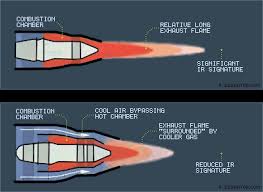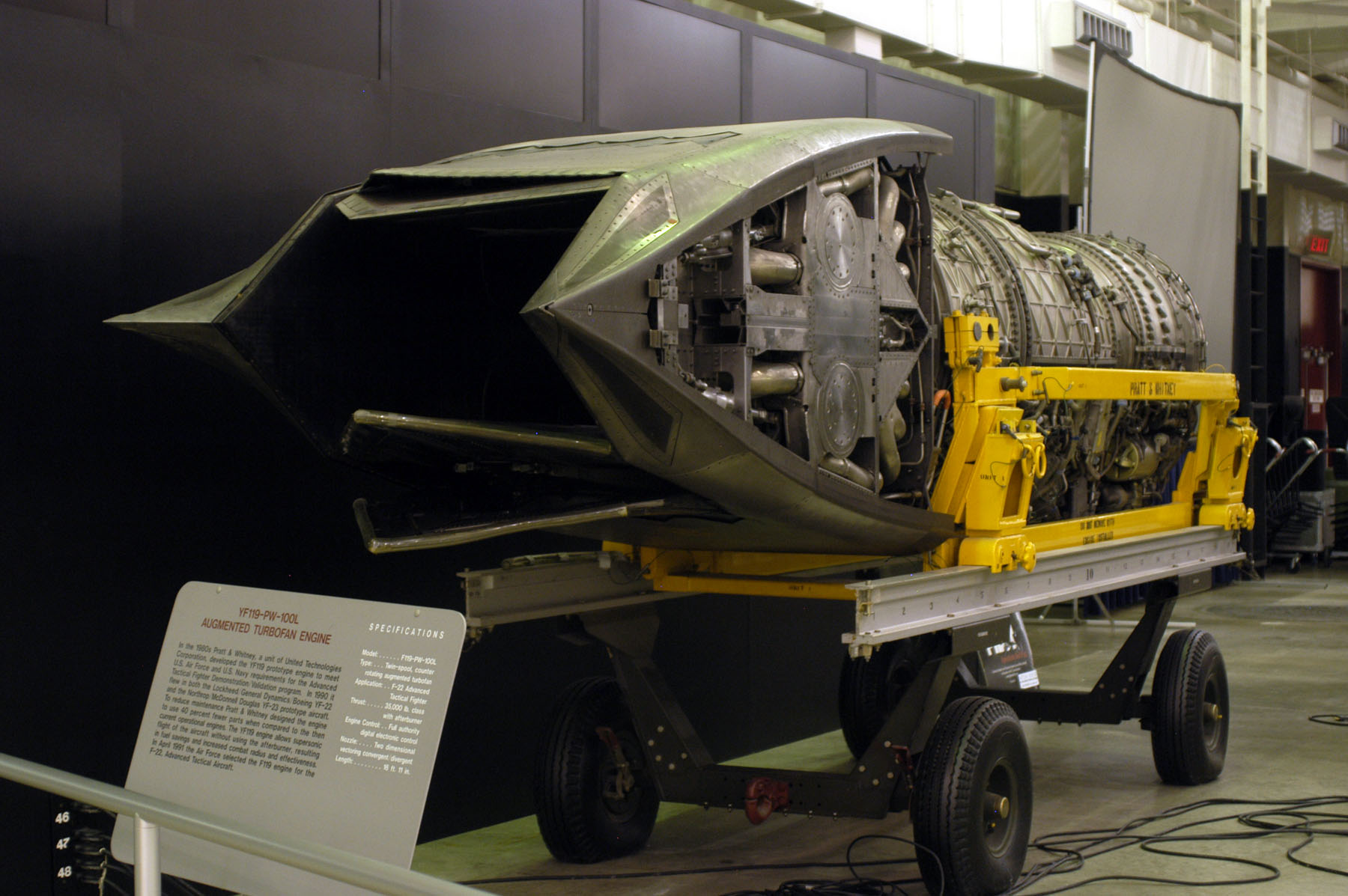How do square nozzles reduce IR?
- Active Member

- Posts: 159
- Joined: 10 Jul 2016, 15:27
I was curious if anyone knew, and is allowed to discuss, how exactly the square nozzles reduce the IR plume of the engines on the F-22. Do the big chevrons generate vortices that stir cool air into the plume, like on the LOAN? Or is it something else? I note that the flat nozzles on the F-117 and B-2 have no obvious vortex-generating features.
- Elite 5K

- Posts: 5269
- Joined: 13 Mar 2013, 08:31
- Location: Finland
AFAIK, they flatten the exhaust plume which make the plume wider and shorter. They also probably generate vortices that mix the cool air with the plume. I think big thing is that engine hot parts are really well shielded from most viewing angles.
Interesting patent: https://patents.google.com/patent/US6000635A/en
and interesting article relating to this: http://www.jmargolin.com/laser/ref7_AWS ... -IR-bw.pdf
Interesting patent: https://patents.google.com/patent/US6000635A/en
and interesting article relating to this: http://www.jmargolin.com/laser/ref7_AWS ... -IR-bw.pdf
- Active Member

- Posts: 159
- Joined: 10 Jul 2016, 15:27
Thanks!
I wonder if LOAN makes flat nozzles obsolete.
I wonder if LOAN makes flat nozzles obsolete.
- Elite 2K

- Posts: 2542
- Joined: 12 Jan 2014, 19:26
collimatrix wrote:Thanks!
I wonder if LOAN makes flat nozzles obsolete.
From my understanding the LOAN was the advantage of being easier to maintain and offers lighter structural weight over the flat serrated nozzles the F-22 uses. However this is a bit of an apples to oranges comparison in some cases. Obviously the LOAN isn't optimized for TVC unlike that of the F-22 which blended TVC along with radar and some IR low observable features. I would think that it is improvement over the conventional "turkey feathers"
- Elite 2K

- Posts: 2542
- Joined: 12 Jan 2014, 19:26
I would think that LM and Pratt&Whitney engineers also added some active IR suppressing measures like introducing ambient air into the exhaust stream

note the gap of separation in the early YF-119 engine test/prototype model

I've also heard or read somewhere that the F-22 has a longer exhaust pipe possibly where cooler ambient air is introduced into the exhaust.
note the gap of separation in the early YF-119 engine test/prototype model

I've also heard or read somewhere that the F-22 has a longer exhaust pipe possibly where cooler ambient air is introduced into the exhaust.
- Active Member

- Posts: 159
- Joined: 10 Jul 2016, 15:27
In theory, the larger a nozzle is the lower an IR signature it should have. The closer the nozzle can get to ideal isentropic expansion, the cooler the exhaust gas should be. Excess heat in the exhaust plume is, after all, energy that isn't being used to make thrust. I'm sure this runs into all sorts of practical limitations.
- Elite 5K

- Posts: 8407
- Joined: 12 Oct 2006, 19:18
- Location: California
That's pretty much what a 3-stream engine is.charlielima223 wrote:I would think that LM and Pratt&Whitney engineers also added some active IR suppressing measures like introducing ambient air into the exhaust stream
"The early bird gets the worm but the second mouse gets the cheese."
- Banned
- Posts: 2848
- Joined: 23 Jul 2013, 16:19
- Location: New Jersey
https://theaviationgeekclub.com/heres-w ... s-dont/amp
Interesting...
More at the jump.
a circular nozzle would compromise the stealth of the F-22 from many rearward angles. Yes, the F-35 has a circular nozzle, and yes, it does compromise the stealth of the F-35 from some rear hemisphere angles. The philosophy with the F-35 design was to concentrate on forward hemisphere stealth and not to spend so much on rearward stealth. The F-35 still has reasonable rear hemisphere stealth, but it cannot come close to the F-22 in that regard.”
The radar in fact will see the F-35 nozzle as a curved continuous surface which will generate specular reflections. “In a very narrow band of frequencies it is stealthy from the rear, but nowhere near as wide a range of frequencies as the F-22,” Knight explains.
Interesting...
More at the jump.
- Elite 5K

- Posts: 9825
- Joined: 19 Dec 2005, 04:14
zero-one wrote:https://theaviationgeekclub.com/heres-why-the-f-22-uses-square-exhaust-nozzles-and-f-35-su-57-and-chinese-stealth-fighters-dont/ampa circular nozzle would compromise the stealth of the F-22 from many rearward angles. Yes, the F-35 has a circular nozzle, and yes, it does compromise the stealth of the F-35 from some rear hemisphere angles. The philosophy with the F-35 design was to concentrate on forward hemisphere stealth and not to spend so much on rearward stealth. The F-35 still has reasonable rear hemisphere stealth, but it cannot come close to the F-22 in that regard.”
The radar in fact will see the F-35 nozzle as a curved continuous surface which will generate specular reflections. “In a very narrow band of frequencies it is stealthy from the rear, but nowhere near as wide a range of frequencies as the F-22,” Knight explains.
Interesting...
More at the jump.
Sounds like more speculation than fact to me....
- Elite 1K

- Posts: 1736
- Joined: 31 Dec 2010, 00:44
- Location: San Antonio, TX
Corsair1963 wrote:Sounds like more speculation than fact to me....
Seems very reasonable to me. The smaller serrations on F135 nozzle compare to big one on F119 would be less effective at lower frequencies because of Rayleigh scattering, it's physics. How big of practical difference that makes, we don't know, but it's still a difference.
But even F-22 nozzle isn't as stealthy as you can get. The nozzle on Lockheed/Boeing/GD A/F-X design is even stealthier though thrust is a bit less. And YF-23 arrangement is also stealthier.
- Elite 5K

- Posts: 9825
- Joined: 19 Dec 2005, 04:14
disconnectedradical wrote:Corsair1963 wrote:Sounds like more speculation than fact to me....
Seems very reasonable to me. The smaller serrations on F135 nozzle compare to big one on F119 would be less effective at lower frequencies because of Rayleigh scattering, it's physics. How big of practical difference that makes, we don't know, but it's still a difference.
But even F-22 nozzle isn't as stealthy as you can get. The nozzle on Lockheed/Boeing/GD A/F-X design is even stealthier though thrust is a bit less. And YF-23 arrangement is also stealthier.
That is like saying the F-22 looks more stealthy than the F-35....
- Elite 1K

- Posts: 1736
- Joined: 31 Dec 2010, 00:44
- Location: San Antonio, TX
Corsair1963 wrote:disconnectedradical wrote:Corsair1963 wrote:Sounds like more speculation than fact to me....
Seems very reasonable to me. The smaller serrations on F135 nozzle compare to big one on F119 would be less effective at lower frequencies because of Rayleigh scattering, it's physics. How big of practical difference that makes, we don't know, but it's still a difference.
But even F-22 nozzle isn't as stealthy as you can get. The nozzle on Lockheed/Boeing/GD A/F-X design is even stealthier though thrust is a bit less. And YF-23 arrangement is also stealthier.
That is like saying the F-22 looks more stealthy than the F-35....
There is difference between just going by looks and knowing how dimensions and size affect interaction with different wavelengths. It's physics, if you can't see beyond that then I can't help you.
- Elite 5K

- Posts: 9825
- Joined: 19 Dec 2005, 04:14
disconnectedradical wrote:
That is like saying the F-22 looks more stealthy than the F-35....
There is difference between just going by looks and knowing how dimensions and size affect interaction with different wavelengths. It's physics, if you can't see beyond that then I can't help you.
WOW, I didn't realize you had the data in regards to the F-22's and F-35's IFR Nozzle Signature. To make that call....
Please, enlighten us....
- Elite 1K

- Posts: 1736
- Joined: 31 Dec 2010, 00:44
- Location: San Antonio, TX
Corsair1963 wrote:disconnectedradical wrote:
That is like saying the F-22 looks more stealthy than the F-35....
There is difference between just going by looks and knowing how dimensions and size affect interaction with different wavelengths. It's physics, if you can't see beyond that then I can't help you.
WOW, I didn't realize you had the data in regards to the F-22's and F-35's IFR Nozzle Signature. To make that call....
Please, enlighten us....
Let me try again. The nozzle serrations on F135 is much smaller than the two large serrations on F119 nozzles. This means bigger serration length on F119 nozzles and also less circular profile. At lower frequencies and longer wavelengths especially when it's longer than the serration of F135 nozzle, the nozzle will appear circular instead of serrated, that's physics, and because of Rayleigh scattering when edge length becomes similar length as wavelength, F135 nozzle will not be as good as F119 nozzle at lower frequencies. At higher frequencies they're probably about equal in stealth. This is basic geometry and scattering.
Now, how much practical difference this makes, no one knows outside of classified information. Since both nozzles are pretty hidden by fuselage and tails, it may not matter that much.
Last edited by disconnectedradical on 13 Jan 2020, 11:24, edited 2 times in total.
- Elite 5K

- Posts: 9825
- Joined: 19 Dec 2005, 04:14
"disconnectedradical"
Let me try again. The nozzle serrations on F135 is much smaller than the two large serrations on F119 nozzles. This means bigger serration length on F119 nozzles and also less circular profile. At lower frequencies and lower wavelengths especially when it's longer than the serration of F135 nozzle, the nozzle will appear circular instead of serrated, that's physics, and because of Rayleigh scattering when edge length becomes similar length as wavelength, F135 nozzle will not be as good as F119 nozzle at lower frequencies. At higher frequencies they're probably about equal in stealth. This is basic geometry and scattering.
Now, how much practical difference this makes, no one knows. Since both nozzles are pretty hidden by fuselage and tails, it may not matter that much.
Get's back to my point about the F-22 looking stealthier than the F-35. Honestly, much we don't know to speculate one way or another. At least without much more information. Than currently available in the public domain.
Which, is not to say your wrong. Just that there maybe variables that we're unaware of....
Respectfully
Who is online
Users browsing this forum: No registered users and 4 guests
